Holmes Institute HI6006: Competitive Strategy Assignment - Tools
VerifiedAdded on 2022/09/21
|8
|2070
|32
Essay
AI Summary
This essay provides a comprehensive discussion of three key strategy development tools: SWOT analysis, PESTLE model, and Porter's Five Forces. It begins with an introduction to strategy development tools and their importance in achieving long-term organizational goals, emphasizing their role in assessing uncertainties and analyzing market situations. The essay then applies these tools to Coles supermarket, a major Australian retailer. The PESTLE analysis examines the external macro-environmental factors impacting Coles, including political, economic, social, technological, legal, and environmental factors. The SWOT analysis assesses Coles' internal strengths and weaknesses, along with external opportunities and threats. Finally, the Porter's Five Forces framework evaluates the competitive forces within the industry, including the bargaining power of suppliers and buyers, the threat of new entrants and substitutes, and industry rivalry. The essay concludes by summarizing how these tools can provide Coles with a competitive edge and help it navigate the dynamic business environment.
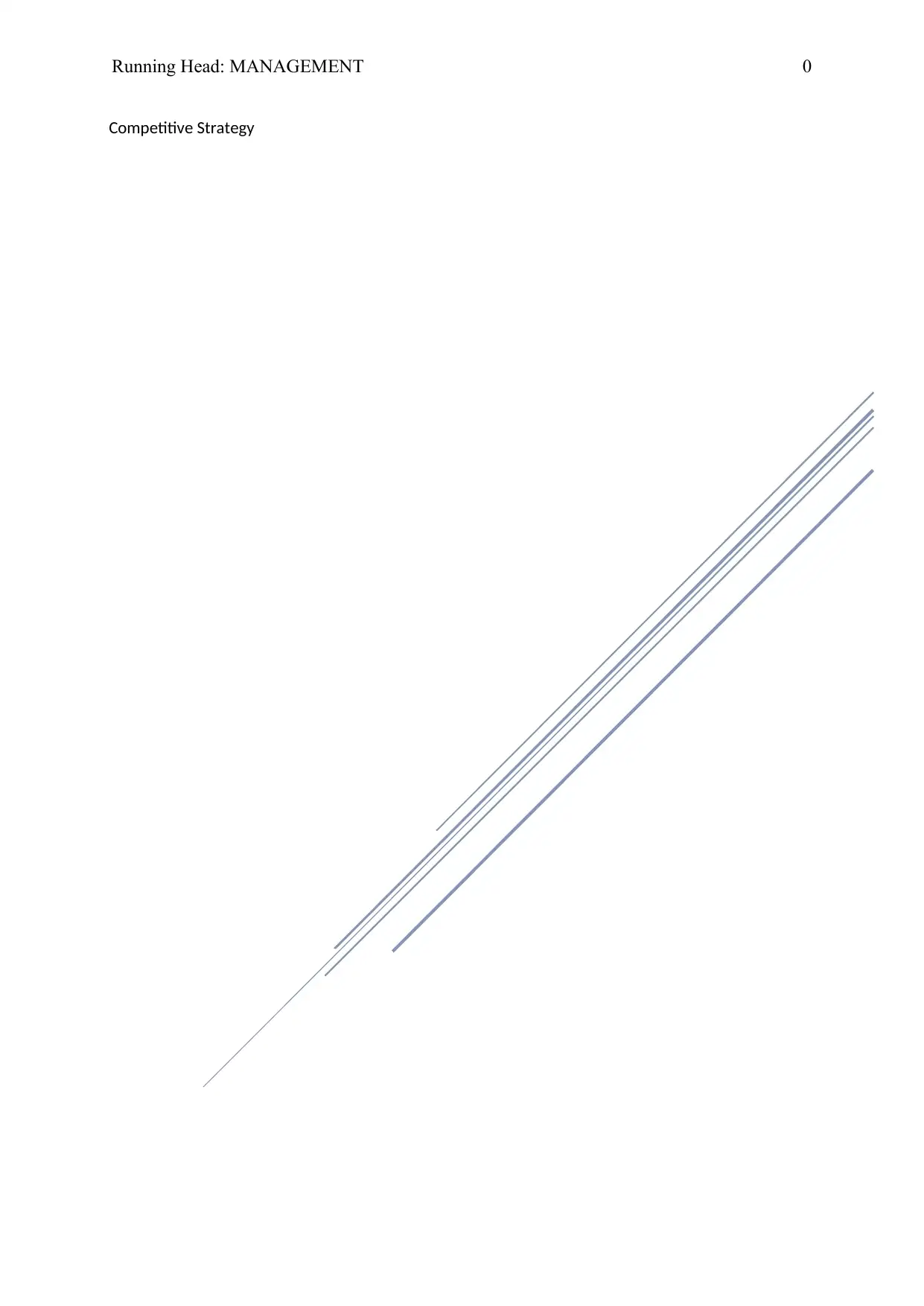
Running Head: MANAGEMENT 0
Competitive Strategy
Competitive Strategy
Paraphrase This Document
Need a fresh take? Get an instant paraphrase of this document with our AI Paraphraser
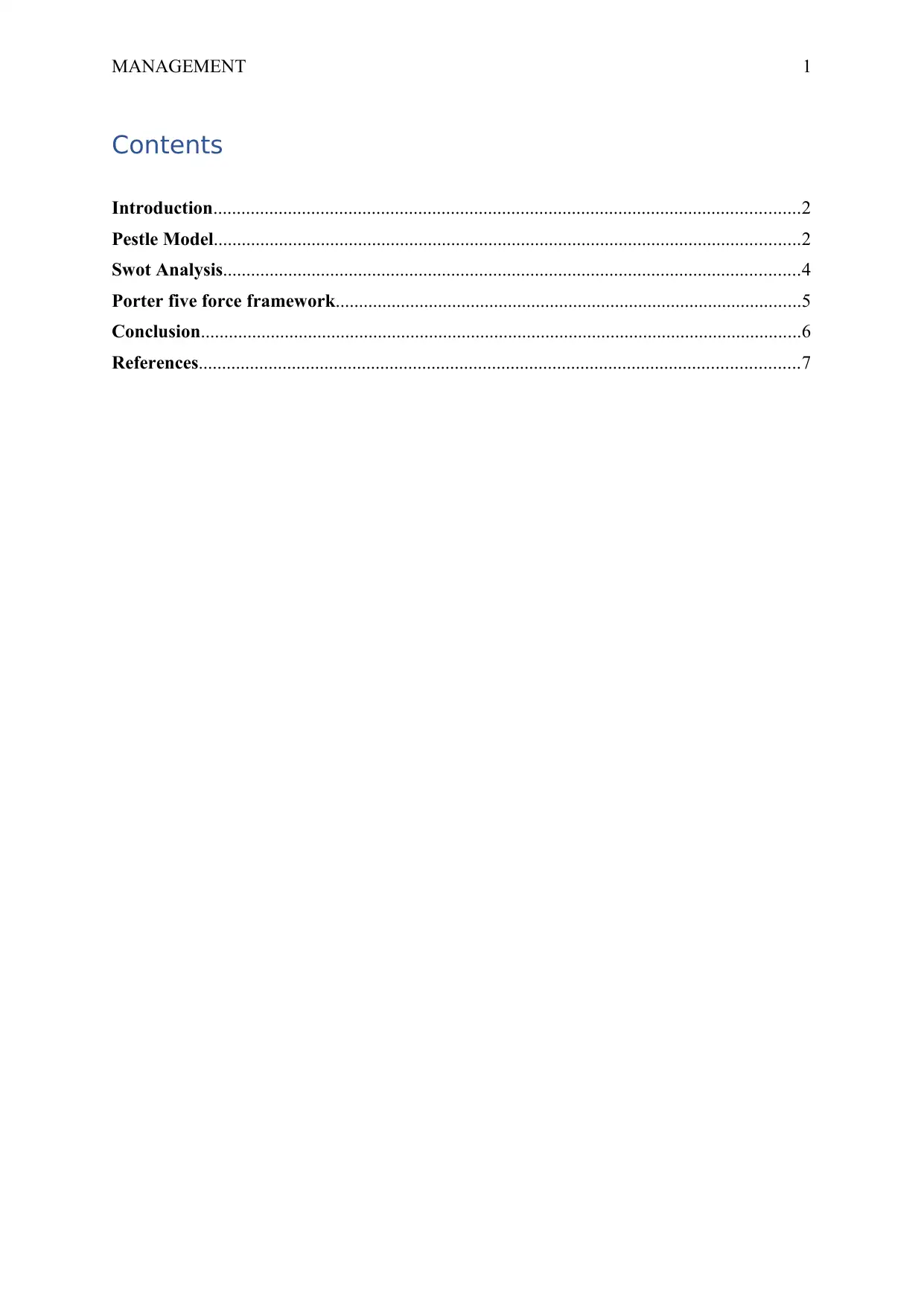
MANAGEMENT 1
Contents
Introduction..............................................................................................................................2
Pestle Model..............................................................................................................................2
Swot Analysis............................................................................................................................4
Porter five force framework....................................................................................................5
Conclusion.................................................................................................................................6
References.................................................................................................................................7
Contents
Introduction..............................................................................................................................2
Pestle Model..............................................................................................................................2
Swot Analysis............................................................................................................................4
Porter five force framework....................................................................................................5
Conclusion.................................................................................................................................6
References.................................................................................................................................7
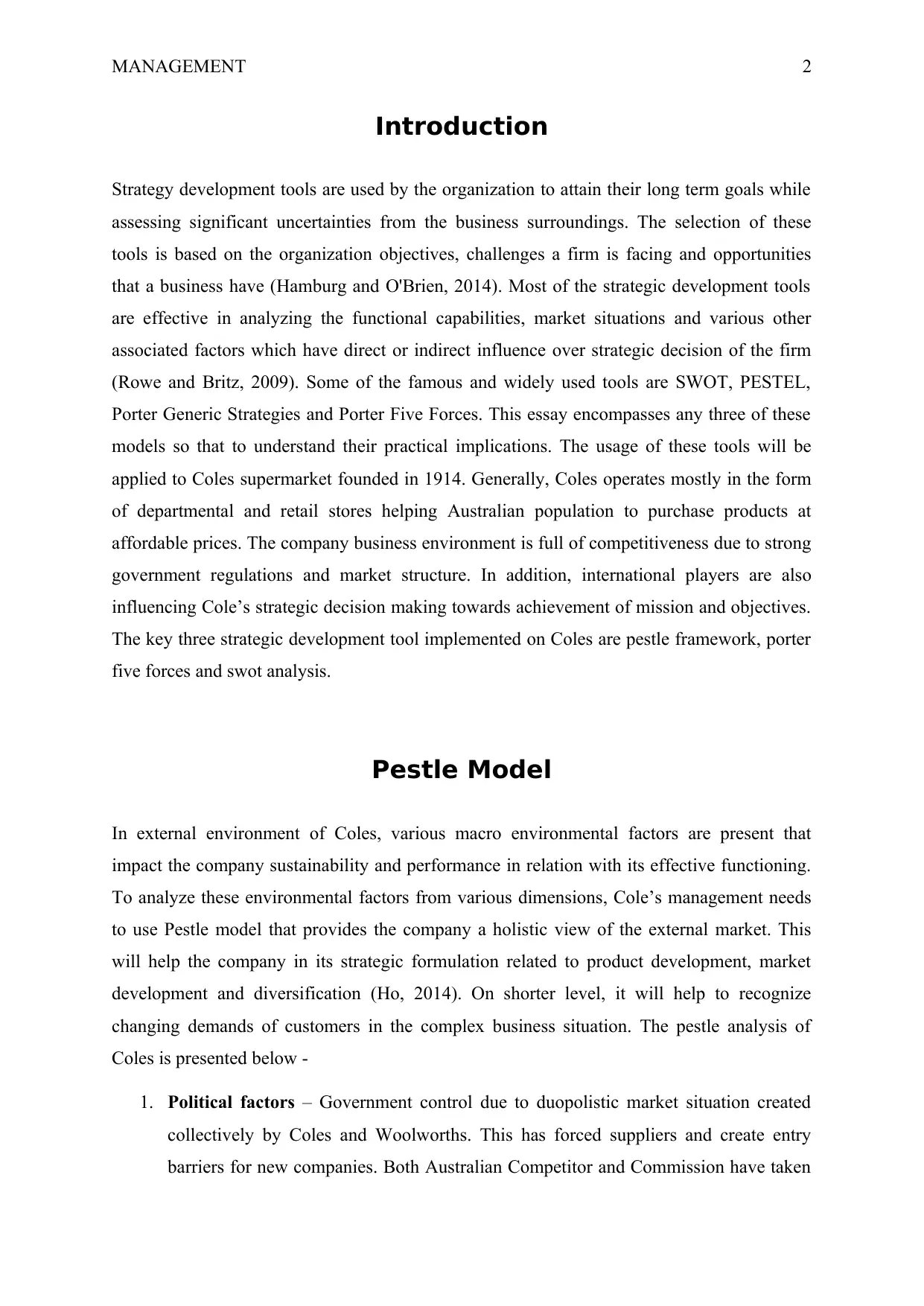
MANAGEMENT 2
Introduction
Strategy development tools are used by the organization to attain their long term goals while
assessing significant uncertainties from the business surroundings. The selection of these
tools is based on the organization objectives, challenges a firm is facing and opportunities
that a business have (Hamburg and O'Brien, 2014). Most of the strategic development tools
are effective in analyzing the functional capabilities, market situations and various other
associated factors which have direct or indirect influence over strategic decision of the firm
(Rowe and Britz, 2009). Some of the famous and widely used tools are SWOT, PESTEL,
Porter Generic Strategies and Porter Five Forces. This essay encompasses any three of these
models so that to understand their practical implications. The usage of these tools will be
applied to Coles supermarket founded in 1914. Generally, Coles operates mostly in the form
of departmental and retail stores helping Australian population to purchase products at
affordable prices. The company business environment is full of competitiveness due to strong
government regulations and market structure. In addition, international players are also
influencing Cole’s strategic decision making towards achievement of mission and objectives.
The key three strategic development tool implemented on Coles are pestle framework, porter
five forces and swot analysis.
Pestle Model
In external environment of Coles, various macro environmental factors are present that
impact the company sustainability and performance in relation with its effective functioning.
To analyze these environmental factors from various dimensions, Cole’s management needs
to use Pestle model that provides the company a holistic view of the external market. This
will help the company in its strategic formulation related to product development, market
development and diversification (Ho, 2014). On shorter level, it will help to recognize
changing demands of customers in the complex business situation. The pestle analysis of
Coles is presented below -
1. Political factors – Government control due to duopolistic market situation created
collectively by Coles and Woolworths. This has forced suppliers and create entry
barriers for new companies. Both Australian Competitor and Commission have taken
Introduction
Strategy development tools are used by the organization to attain their long term goals while
assessing significant uncertainties from the business surroundings. The selection of these
tools is based on the organization objectives, challenges a firm is facing and opportunities
that a business have (Hamburg and O'Brien, 2014). Most of the strategic development tools
are effective in analyzing the functional capabilities, market situations and various other
associated factors which have direct or indirect influence over strategic decision of the firm
(Rowe and Britz, 2009). Some of the famous and widely used tools are SWOT, PESTEL,
Porter Generic Strategies and Porter Five Forces. This essay encompasses any three of these
models so that to understand their practical implications. The usage of these tools will be
applied to Coles supermarket founded in 1914. Generally, Coles operates mostly in the form
of departmental and retail stores helping Australian population to purchase products at
affordable prices. The company business environment is full of competitiveness due to strong
government regulations and market structure. In addition, international players are also
influencing Cole’s strategic decision making towards achievement of mission and objectives.
The key three strategic development tool implemented on Coles are pestle framework, porter
five forces and swot analysis.
Pestle Model
In external environment of Coles, various macro environmental factors are present that
impact the company sustainability and performance in relation with its effective functioning.
To analyze these environmental factors from various dimensions, Cole’s management needs
to use Pestle model that provides the company a holistic view of the external market. This
will help the company in its strategic formulation related to product development, market
development and diversification (Ho, 2014). On shorter level, it will help to recognize
changing demands of customers in the complex business situation. The pestle analysis of
Coles is presented below -
1. Political factors – Government control due to duopolistic market situation created
collectively by Coles and Woolworths. This has forced suppliers and create entry
barriers for new companies. Both Australian Competitor and Commission have taken
⊘ This is a preview!⊘
Do you want full access?
Subscribe today to unlock all pages.

Trusted by 1+ million students worldwide
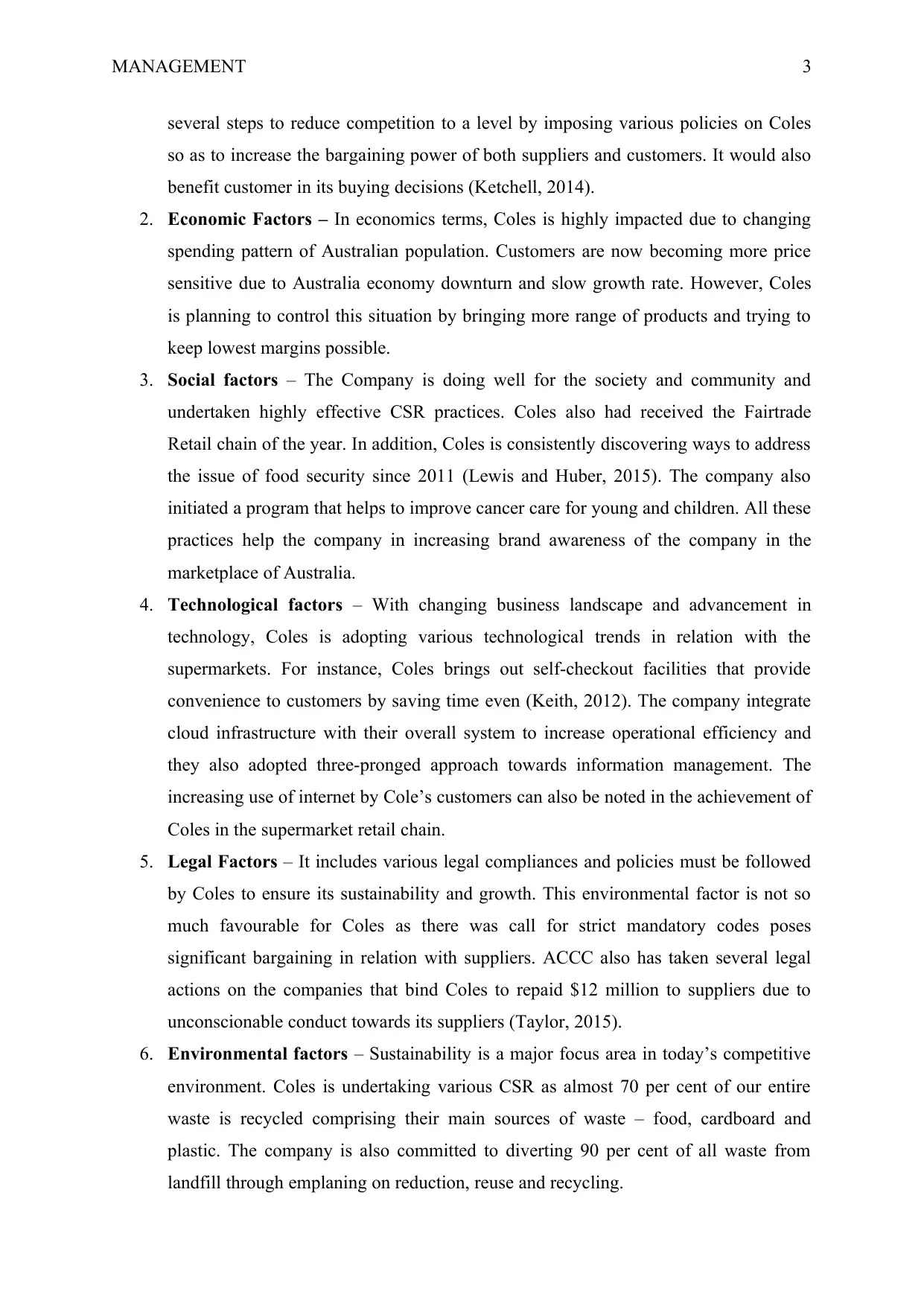
MANAGEMENT 3
several steps to reduce competition to a level by imposing various policies on Coles
so as to increase the bargaining power of both suppliers and customers. It would also
benefit customer in its buying decisions (Ketchell, 2014).
2. Economic Factors – In economics terms, Coles is highly impacted due to changing
spending pattern of Australian population. Customers are now becoming more price
sensitive due to Australia economy downturn and slow growth rate. However, Coles
is planning to control this situation by bringing more range of products and trying to
keep lowest margins possible.
3. Social factors – The Company is doing well for the society and community and
undertaken highly effective CSR practices. Coles also had received the Fairtrade
Retail chain of the year. In addition, Coles is consistently discovering ways to address
the issue of food security since 2011 (Lewis and Huber, 2015). The company also
initiated a program that helps to improve cancer care for young and children. All these
practices help the company in increasing brand awareness of the company in the
marketplace of Australia.
4. Technological factors – With changing business landscape and advancement in
technology, Coles is adopting various technological trends in relation with the
supermarkets. For instance, Coles brings out self-checkout facilities that provide
convenience to customers by saving time even (Keith, 2012). The company integrate
cloud infrastructure with their overall system to increase operational efficiency and
they also adopted three-pronged approach towards information management. The
increasing use of internet by Cole’s customers can also be noted in the achievement of
Coles in the supermarket retail chain.
5. Legal Factors – It includes various legal compliances and policies must be followed
by Coles to ensure its sustainability and growth. This environmental factor is not so
much favourable for Coles as there was call for strict mandatory codes poses
significant bargaining in relation with suppliers. ACCC also has taken several legal
actions on the companies that bind Coles to repaid $12 million to suppliers due to
unconscionable conduct towards its suppliers (Taylor, 2015).
6. Environmental factors – Sustainability is a major focus area in today’s competitive
environment. Coles is undertaking various CSR as almost 70 per cent of our entire
waste is recycled comprising their main sources of waste – food, cardboard and
plastic. The company is also committed to diverting 90 per cent of all waste from
landfill through emplaning on reduction, reuse and recycling.
several steps to reduce competition to a level by imposing various policies on Coles
so as to increase the bargaining power of both suppliers and customers. It would also
benefit customer in its buying decisions (Ketchell, 2014).
2. Economic Factors – In economics terms, Coles is highly impacted due to changing
spending pattern of Australian population. Customers are now becoming more price
sensitive due to Australia economy downturn and slow growth rate. However, Coles
is planning to control this situation by bringing more range of products and trying to
keep lowest margins possible.
3. Social factors – The Company is doing well for the society and community and
undertaken highly effective CSR practices. Coles also had received the Fairtrade
Retail chain of the year. In addition, Coles is consistently discovering ways to address
the issue of food security since 2011 (Lewis and Huber, 2015). The company also
initiated a program that helps to improve cancer care for young and children. All these
practices help the company in increasing brand awareness of the company in the
marketplace of Australia.
4. Technological factors – With changing business landscape and advancement in
technology, Coles is adopting various technological trends in relation with the
supermarkets. For instance, Coles brings out self-checkout facilities that provide
convenience to customers by saving time even (Keith, 2012). The company integrate
cloud infrastructure with their overall system to increase operational efficiency and
they also adopted three-pronged approach towards information management. The
increasing use of internet by Cole’s customers can also be noted in the achievement of
Coles in the supermarket retail chain.
5. Legal Factors – It includes various legal compliances and policies must be followed
by Coles to ensure its sustainability and growth. This environmental factor is not so
much favourable for Coles as there was call for strict mandatory codes poses
significant bargaining in relation with suppliers. ACCC also has taken several legal
actions on the companies that bind Coles to repaid $12 million to suppliers due to
unconscionable conduct towards its suppliers (Taylor, 2015).
6. Environmental factors – Sustainability is a major focus area in today’s competitive
environment. Coles is undertaking various CSR as almost 70 per cent of our entire
waste is recycled comprising their main sources of waste – food, cardboard and
plastic. The company is also committed to diverting 90 per cent of all waste from
landfill through emplaning on reduction, reuse and recycling.
Paraphrase This Document
Need a fresh take? Get an instant paraphrase of this document with our AI Paraphraser
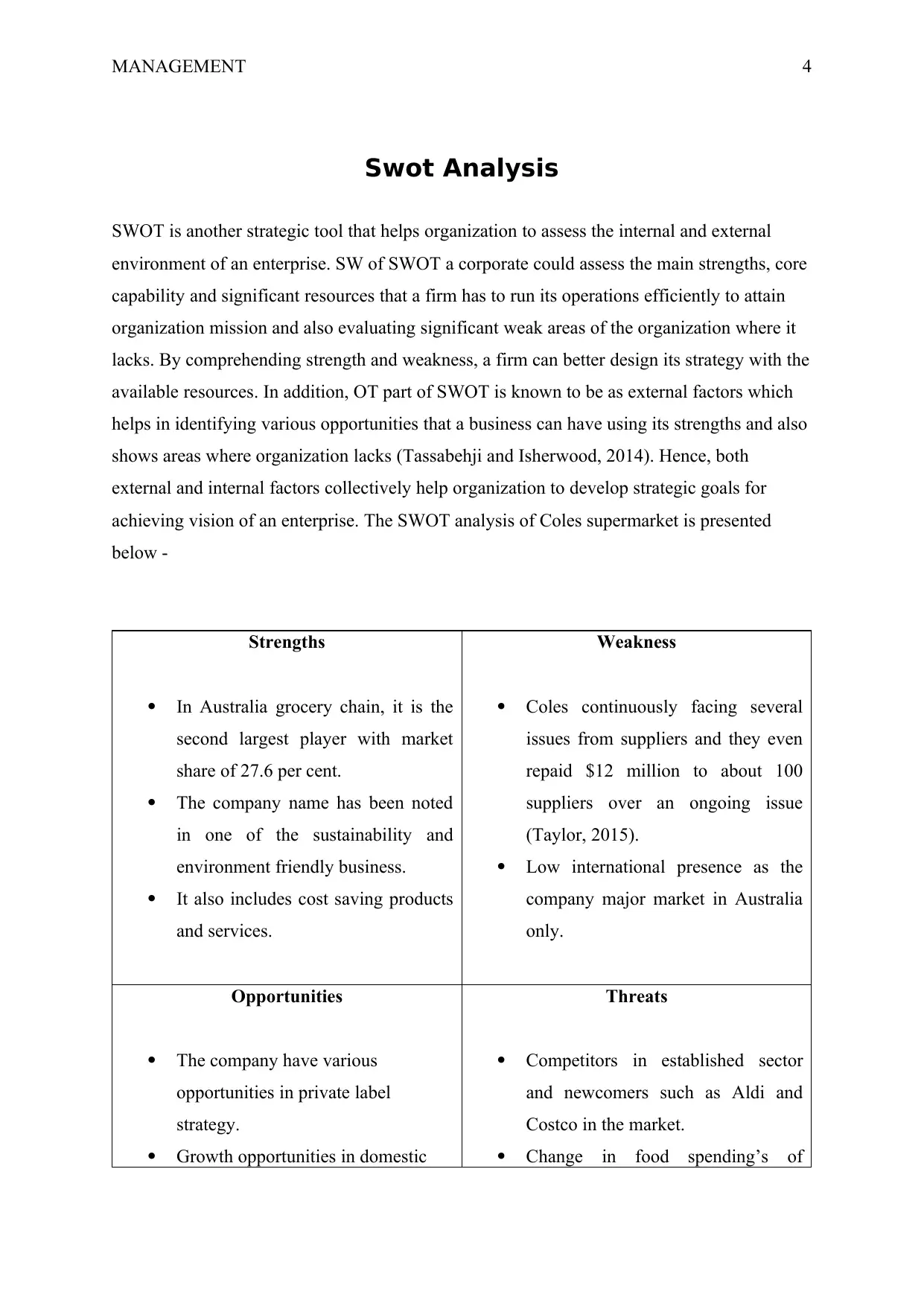
MANAGEMENT 4
Swot Analysis
SWOT is another strategic tool that helps organization to assess the internal and external
environment of an enterprise. SW of SWOT a corporate could assess the main strengths, core
capability and significant resources that a firm has to run its operations efficiently to attain
organization mission and also evaluating significant weak areas of the organization where it
lacks. By comprehending strength and weakness, a firm can better design its strategy with the
available resources. In addition, OT part of SWOT is known to be as external factors which
helps in identifying various opportunities that a business can have using its strengths and also
shows areas where organization lacks (Tassabehji and Isherwood, 2014). Hence, both
external and internal factors collectively help organization to develop strategic goals for
achieving vision of an enterprise. The SWOT analysis of Coles supermarket is presented
below -
Strengths
In Australia grocery chain, it is the
second largest player with market
share of 27.6 per cent.
The company name has been noted
in one of the sustainability and
environment friendly business.
It also includes cost saving products
and services.
Weakness
Coles continuously facing several
issues from suppliers and they even
repaid $12 million to about 100
suppliers over an ongoing issue
(Taylor, 2015).
Low international presence as the
company major market in Australia
only.
Opportunities
The company have various
opportunities in private label
strategy.
Growth opportunities in domestic
Threats
Competitors in established sector
and newcomers such as Aldi and
Costco in the market.
Change in food spending’s of
Swot Analysis
SWOT is another strategic tool that helps organization to assess the internal and external
environment of an enterprise. SW of SWOT a corporate could assess the main strengths, core
capability and significant resources that a firm has to run its operations efficiently to attain
organization mission and also evaluating significant weak areas of the organization where it
lacks. By comprehending strength and weakness, a firm can better design its strategy with the
available resources. In addition, OT part of SWOT is known to be as external factors which
helps in identifying various opportunities that a business can have using its strengths and also
shows areas where organization lacks (Tassabehji and Isherwood, 2014). Hence, both
external and internal factors collectively help organization to develop strategic goals for
achieving vision of an enterprise. The SWOT analysis of Coles supermarket is presented
below -
Strengths
In Australia grocery chain, it is the
second largest player with market
share of 27.6 per cent.
The company name has been noted
in one of the sustainability and
environment friendly business.
It also includes cost saving products
and services.
Weakness
Coles continuously facing several
issues from suppliers and they even
repaid $12 million to about 100
suppliers over an ongoing issue
(Taylor, 2015).
Low international presence as the
company major market in Australia
only.
Opportunities
The company have various
opportunities in private label
strategy.
Growth opportunities in domestic
Threats
Competitors in established sector
and newcomers such as Aldi and
Costco in the market.
Change in food spending’s of
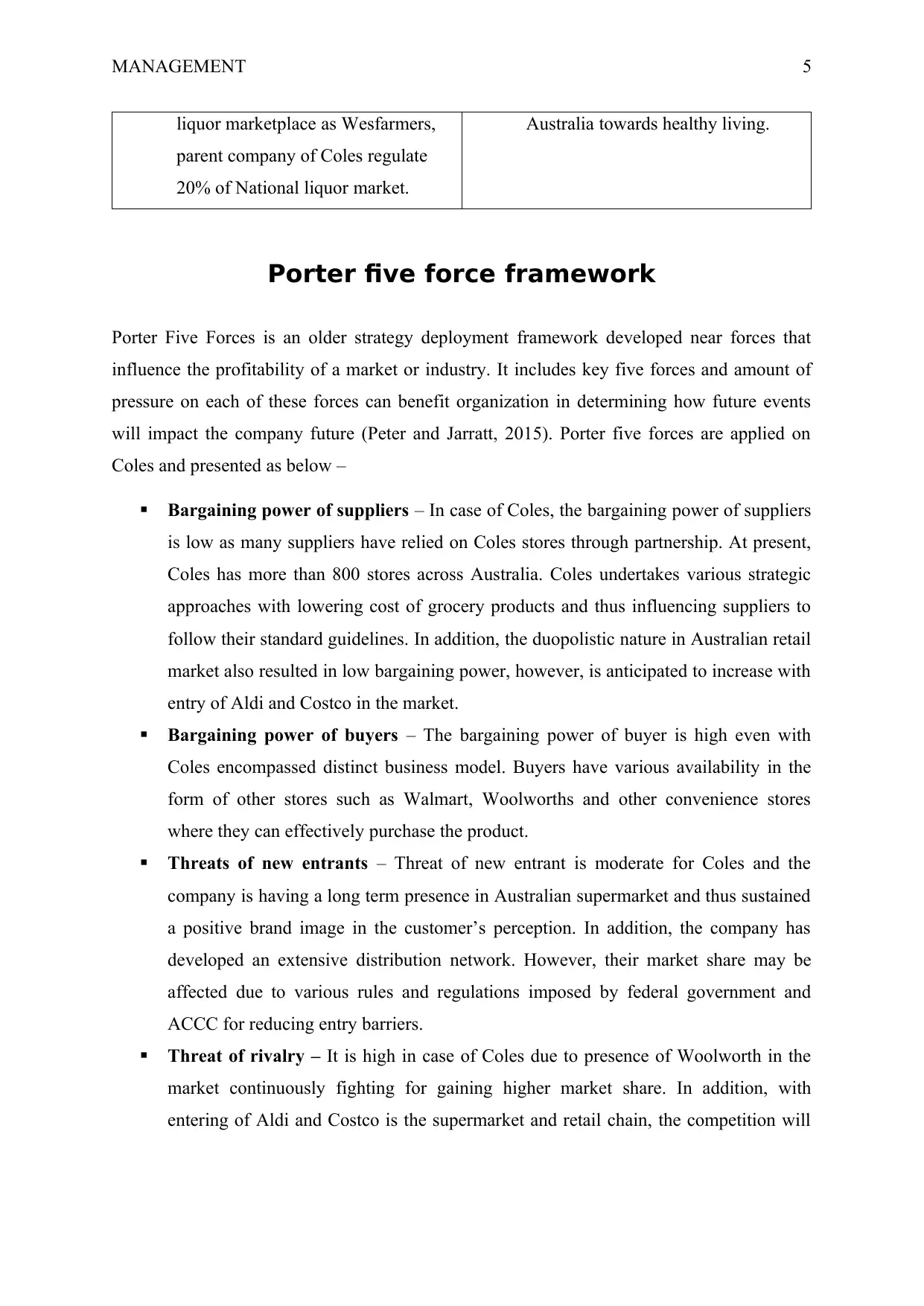
MANAGEMENT 5
liquor marketplace as Wesfarmers,
parent company of Coles regulate
20% of National liquor market.
Australia towards healthy living.
Porter five force framework
Porter Five Forces is an older strategy deployment framework developed near forces that
influence the profitability of a market or industry. It includes key five forces and amount of
pressure on each of these forces can benefit organization in determining how future events
will impact the company future (Peter and Jarratt, 2015). Porter five forces are applied on
Coles and presented as below –
Bargaining power of suppliers – In case of Coles, the bargaining power of suppliers
is low as many suppliers have relied on Coles stores through partnership. At present,
Coles has more than 800 stores across Australia. Coles undertakes various strategic
approaches with lowering cost of grocery products and thus influencing suppliers to
follow their standard guidelines. In addition, the duopolistic nature in Australian retail
market also resulted in low bargaining power, however, is anticipated to increase with
entry of Aldi and Costco in the market.
Bargaining power of buyers – The bargaining power of buyer is high even with
Coles encompassed distinct business model. Buyers have various availability in the
form of other stores such as Walmart, Woolworths and other convenience stores
where they can effectively purchase the product.
Threats of new entrants – Threat of new entrant is moderate for Coles and the
company is having a long term presence in Australian supermarket and thus sustained
a positive brand image in the customer’s perception. In addition, the company has
developed an extensive distribution network. However, their market share may be
affected due to various rules and regulations imposed by federal government and
ACCC for reducing entry barriers.
Threat of rivalry – It is high in case of Coles due to presence of Woolworth in the
market continuously fighting for gaining higher market share. In addition, with
entering of Aldi and Costco is the supermarket and retail chain, the competition will
liquor marketplace as Wesfarmers,
parent company of Coles regulate
20% of National liquor market.
Australia towards healthy living.
Porter five force framework
Porter Five Forces is an older strategy deployment framework developed near forces that
influence the profitability of a market or industry. It includes key five forces and amount of
pressure on each of these forces can benefit organization in determining how future events
will impact the company future (Peter and Jarratt, 2015). Porter five forces are applied on
Coles and presented as below –
Bargaining power of suppliers – In case of Coles, the bargaining power of suppliers
is low as many suppliers have relied on Coles stores through partnership. At present,
Coles has more than 800 stores across Australia. Coles undertakes various strategic
approaches with lowering cost of grocery products and thus influencing suppliers to
follow their standard guidelines. In addition, the duopolistic nature in Australian retail
market also resulted in low bargaining power, however, is anticipated to increase with
entry of Aldi and Costco in the market.
Bargaining power of buyers – The bargaining power of buyer is high even with
Coles encompassed distinct business model. Buyers have various availability in the
form of other stores such as Walmart, Woolworths and other convenience stores
where they can effectively purchase the product.
Threats of new entrants – Threat of new entrant is moderate for Coles and the
company is having a long term presence in Australian supermarket and thus sustained
a positive brand image in the customer’s perception. In addition, the company has
developed an extensive distribution network. However, their market share may be
affected due to various rules and regulations imposed by federal government and
ACCC for reducing entry barriers.
Threat of rivalry – It is high in case of Coles due to presence of Woolworth in the
market continuously fighting for gaining higher market share. In addition, with
entering of Aldi and Costco is the supermarket and retail chain, the competition will
⊘ This is a preview!⊘
Do you want full access?
Subscribe today to unlock all pages.

Trusted by 1+ million students worldwide
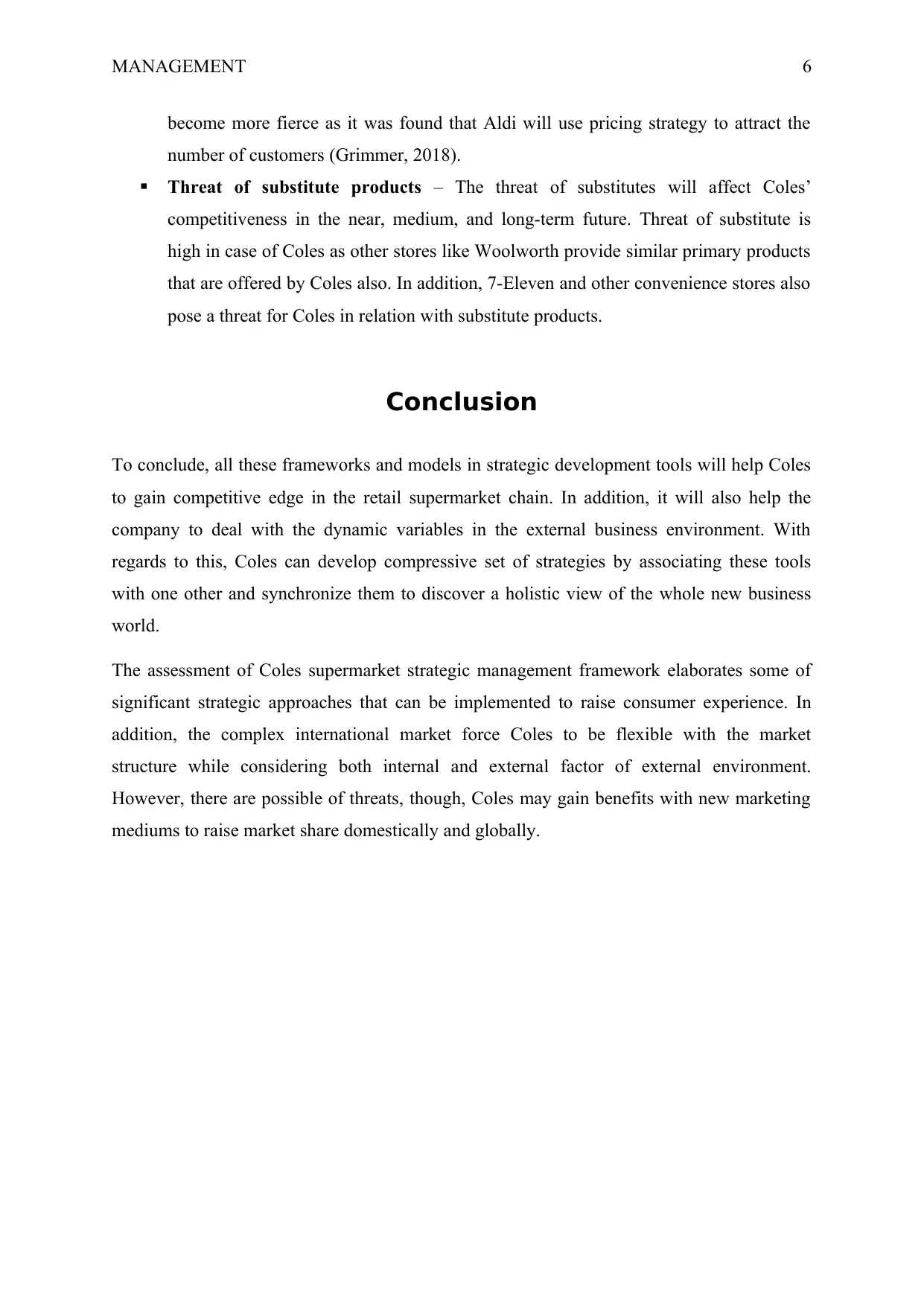
MANAGEMENT 6
become more fierce as it was found that Aldi will use pricing strategy to attract the
number of customers (Grimmer, 2018).
Threat of substitute products – The threat of substitutes will affect Coles’
competitiveness in the near, medium, and long-term future. Threat of substitute is
high in case of Coles as other stores like Woolworth provide similar primary products
that are offered by Coles also. In addition, 7-Eleven and other convenience stores also
pose a threat for Coles in relation with substitute products.
Conclusion
To conclude, all these frameworks and models in strategic development tools will help Coles
to gain competitive edge in the retail supermarket chain. In addition, it will also help the
company to deal with the dynamic variables in the external business environment. With
regards to this, Coles can develop compressive set of strategies by associating these tools
with one other and synchronize them to discover a holistic view of the whole new business
world.
The assessment of Coles supermarket strategic management framework elaborates some of
significant strategic approaches that can be implemented to raise consumer experience. In
addition, the complex international market force Coles to be flexible with the market
structure while considering both internal and external factor of external environment.
However, there are possible of threats, though, Coles may gain benefits with new marketing
mediums to raise market share domestically and globally.
become more fierce as it was found that Aldi will use pricing strategy to attract the
number of customers (Grimmer, 2018).
Threat of substitute products – The threat of substitutes will affect Coles’
competitiveness in the near, medium, and long-term future. Threat of substitute is
high in case of Coles as other stores like Woolworth provide similar primary products
that are offered by Coles also. In addition, 7-Eleven and other convenience stores also
pose a threat for Coles in relation with substitute products.
Conclusion
To conclude, all these frameworks and models in strategic development tools will help Coles
to gain competitive edge in the retail supermarket chain. In addition, it will also help the
company to deal with the dynamic variables in the external business environment. With
regards to this, Coles can develop compressive set of strategies by associating these tools
with one other and synchronize them to discover a holistic view of the whole new business
world.
The assessment of Coles supermarket strategic management framework elaborates some of
significant strategic approaches that can be implemented to raise consumer experience. In
addition, the complex international market force Coles to be flexible with the market
structure while considering both internal and external factor of external environment.
However, there are possible of threats, though, Coles may gain benefits with new marketing
mediums to raise market share domestically and globally.
Paraphrase This Document
Need a fresh take? Get an instant paraphrase of this document with our AI Paraphraser
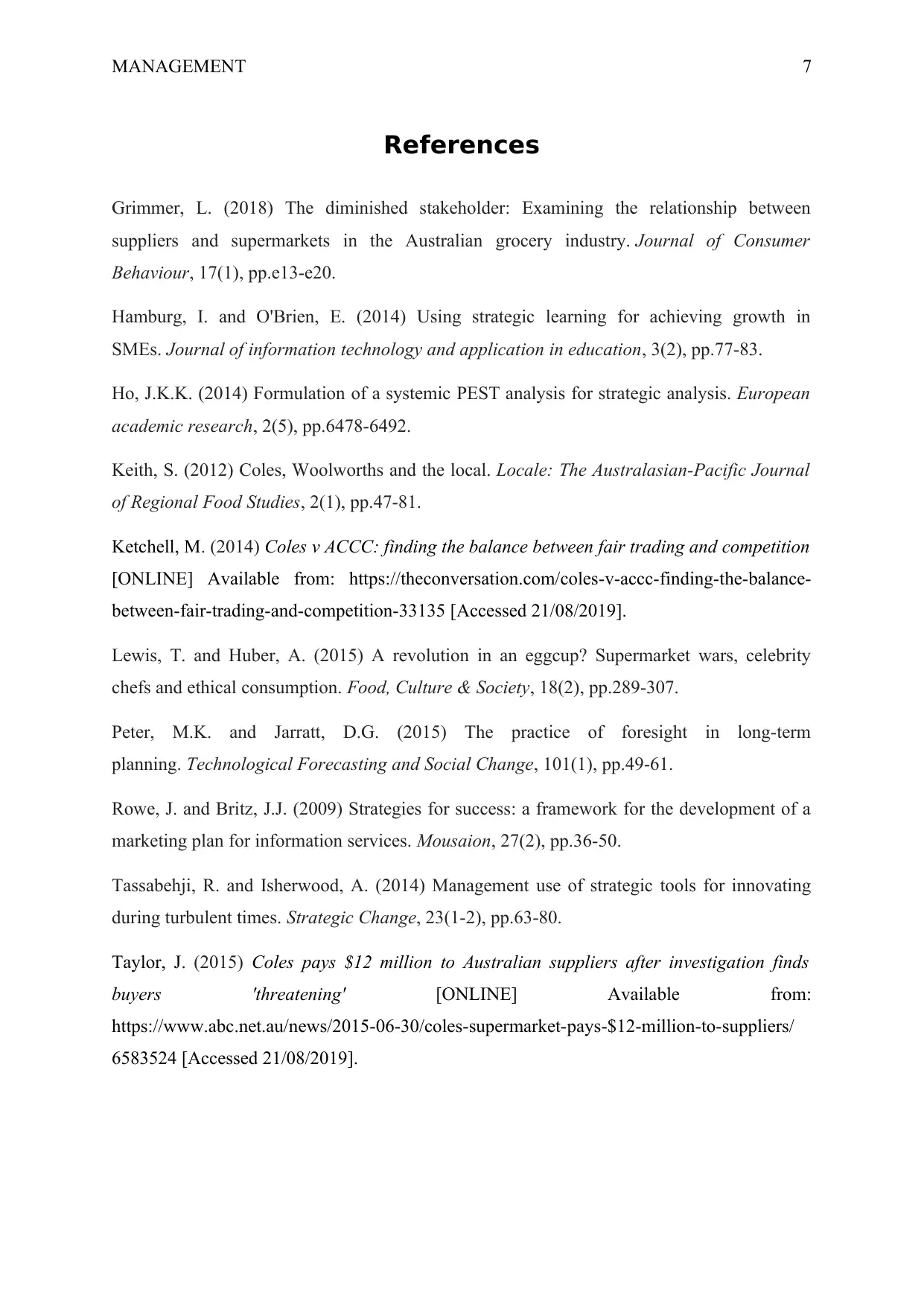
MANAGEMENT 7
References
Grimmer, L. (2018) The diminished stakeholder: Examining the relationship between
suppliers and supermarkets in the Australian grocery industry. Journal of Consumer
Behaviour, 17(1), pp.e13-e20.
Hamburg, I. and O'Brien, E. (2014) Using strategic learning for achieving growth in
SMEs. Journal of information technology and application in education, 3(2), pp.77-83.
Ho, J.K.K. (2014) Formulation of a systemic PEST analysis for strategic analysis. European
academic research, 2(5), pp.6478-6492.
Keith, S. (2012) Coles, Woolworths and the local. Locale: The Australasian-Pacific Journal
of Regional Food Studies, 2(1), pp.47-81.
Ketchell, M. (2014) Coles v ACCC: finding the balance between fair trading and competition
[ONLINE] Available from: https://theconversation.com/coles-v-accc-finding-the-balance-
between-fair-trading-and-competition-33135 [Accessed 21/08/2019].
Lewis, T. and Huber, A. (2015) A revolution in an eggcup? Supermarket wars, celebrity
chefs and ethical consumption. Food, Culture & Society, 18(2), pp.289-307.
Peter, M.K. and Jarratt, D.G. (2015) The practice of foresight in long-term
planning. Technological Forecasting and Social Change, 101(1), pp.49-61.
Rowe, J. and Britz, J.J. (2009) Strategies for success: a framework for the development of a
marketing plan for information services. Mousaion, 27(2), pp.36-50.
Tassabehji, R. and Isherwood, A. (2014) Management use of strategic tools for innovating
during turbulent times. Strategic Change, 23(1‐2), pp.63-80.
Taylor, J. (2015) Coles pays $12 million to Australian suppliers after investigation finds
buyers 'threatening' [ONLINE] Available from:
https://www.abc.net.au/news/2015-06-30/coles-supermarket-pays-$12-million-to-suppliers/
6583524 [Accessed 21/08/2019].
References
Grimmer, L. (2018) The diminished stakeholder: Examining the relationship between
suppliers and supermarkets in the Australian grocery industry. Journal of Consumer
Behaviour, 17(1), pp.e13-e20.
Hamburg, I. and O'Brien, E. (2014) Using strategic learning for achieving growth in
SMEs. Journal of information technology and application in education, 3(2), pp.77-83.
Ho, J.K.K. (2014) Formulation of a systemic PEST analysis for strategic analysis. European
academic research, 2(5), pp.6478-6492.
Keith, S. (2012) Coles, Woolworths and the local. Locale: The Australasian-Pacific Journal
of Regional Food Studies, 2(1), pp.47-81.
Ketchell, M. (2014) Coles v ACCC: finding the balance between fair trading and competition
[ONLINE] Available from: https://theconversation.com/coles-v-accc-finding-the-balance-
between-fair-trading-and-competition-33135 [Accessed 21/08/2019].
Lewis, T. and Huber, A. (2015) A revolution in an eggcup? Supermarket wars, celebrity
chefs and ethical consumption. Food, Culture & Society, 18(2), pp.289-307.
Peter, M.K. and Jarratt, D.G. (2015) The practice of foresight in long-term
planning. Technological Forecasting and Social Change, 101(1), pp.49-61.
Rowe, J. and Britz, J.J. (2009) Strategies for success: a framework for the development of a
marketing plan for information services. Mousaion, 27(2), pp.36-50.
Tassabehji, R. and Isherwood, A. (2014) Management use of strategic tools for innovating
during turbulent times. Strategic Change, 23(1‐2), pp.63-80.
Taylor, J. (2015) Coles pays $12 million to Australian suppliers after investigation finds
buyers 'threatening' [ONLINE] Available from:
https://www.abc.net.au/news/2015-06-30/coles-supermarket-pays-$12-million-to-suppliers/
6583524 [Accessed 21/08/2019].
1 out of 8
Related Documents
Your All-in-One AI-Powered Toolkit for Academic Success.
+13062052269
info@desklib.com
Available 24*7 on WhatsApp / Email
![[object Object]](/_next/static/media/star-bottom.7253800d.svg)
Unlock your academic potential
Copyright © 2020–2025 A2Z Services. All Rights Reserved. Developed and managed by ZUCOL.


